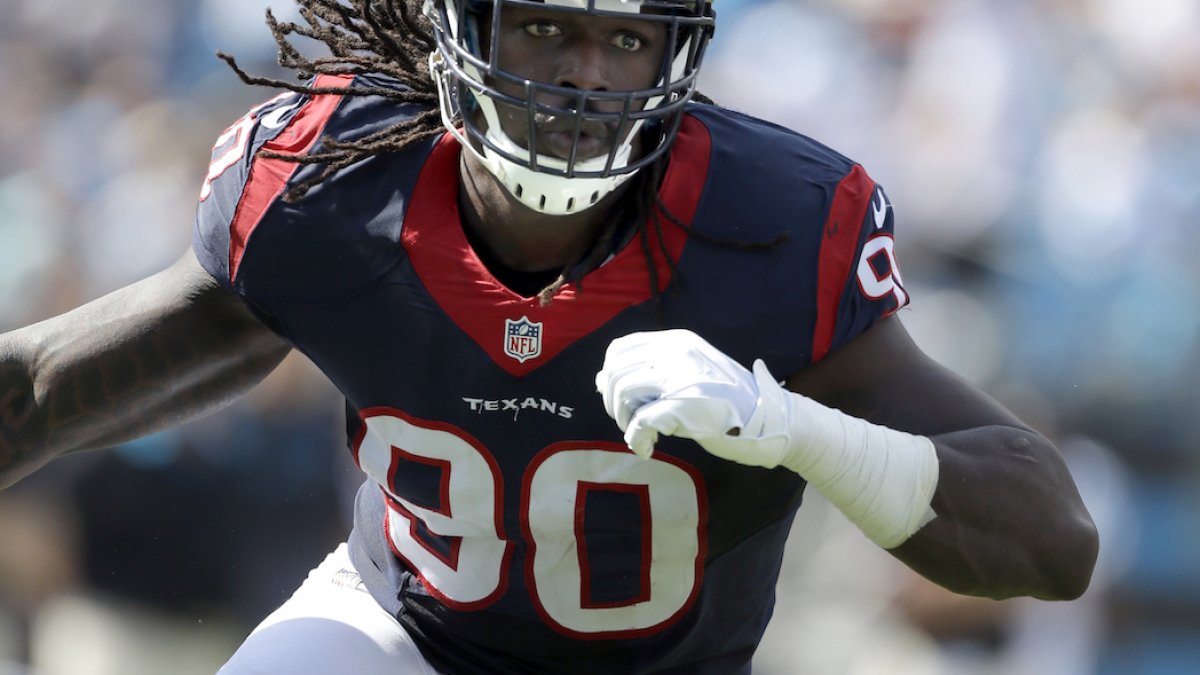Editor’s note: Every weekday in “Daily Focus,” PFF analysts take the latest NFL news and translate what it really means for each team involved.
Jadeveon Clowney claims to be 100 percent healthy, and is now facing a make-or-break season: The No. 1 overall pick from 2014 says he is 100 percent healthy following the Houston Texans' first OTAs, and needs a season of luck on the injury front to become the player he was projected to be when he was drafted that high. Perilously close to being labeled a bust by many, Clowney actually played very well in 2015 when he saw the field after missing almost his entire rookie season. He graded well against both the run and pass, and formed a formidable front with Whitney Mercilus and J.J. Watt.
Injuries have essentially put Clowney at least a year behind the curve, as last year was what we might have expected his rookie season to look like. Entering Year 3, he has the chance to turn those flashes into routine excellence and become truly special, but he needs to be on the field consistently for that to happen. Over two seasons Clowney has played just 719 snaps for the Texans, which is almost 200 fewer than Watt has managed in every single season of his career, and more than 300 fewer than he has played in most years.
Browns cutting Brian Hartline opens up a competition at WR: After making some trades, the Browns ended up with 14 total selections in the 2016 draft, seemingly putting a premium on the number of players they were acquiring in order to increase their chances of gaining quality players. At no position was that strategy more apparent than at wide receiver, as they accounted for four of those 14 picks.
They are at least going to see what comes from those four players by giving them all the reps possible, and they gave that a helping hand by releasing veteran Brian Hartline yesterday.
Hartline accounted for 526 snaps on offense in 2015, which is the most among receivers that were on the roster at the start of this week. When you add in Travis Benjamin, who was lost to San Diego in free agency, the Browns have 1,301 snaps from last year to find among new receivers. The bulk of those will go to first-round pick Corey Coleman – the No. 1 WR on PFF’s draft board – but that still leaves a substantial role or roles to be earned from the remaining three receivers: Ricardo Lewis (Auburn), Jordan Payton (UCLA) and Rashard Higgins (Colorado State).
All three players graded well for PFF last season, and are all over the map from an athletic standpoint, but the most interesting player of the three is perhaps Higgins, who was No. 40 on PFF’s big board and who led the draft class in grade in 2014 when he had a viable quarterback throwing him the ball.
That year we saw something pretty special from Higgins, and the suggestion that despite his measurables profile — which is among the lowest you will ever see at the position — he can succeed and be productive at the NFL level.
At the very least the Browns are freeing up the reps to let these three receivers battle throughout OTAs, minicamp and preseason to see if somebody emerges and earns those available snaps on offense.
Atlanta's Vic Beasley is learning a new position in Year 2: While it may not have been reflected in sack numbers, Vic Beasley’s rookie season was actually relatively impressive and productive. He was one of only four rookie edge rushers to grade well, and had the highest pass-rushing grade of the class. He didn’t wow with his sack numbers (four total), he did notch 42 total pressures on 387 rushes, which is a good rate.
His grade against the run was not as good, however, and the Falcons are going to try and make use of his athleticism by asking him to become a dual-role player. He is essentially being moved from 4-3 defensive end to the position Bruce Irvin used to play within the Seahawks' scheme (where Atlanta head coach Dan Quinn was previously the defensive coordinator): off-the-ball linebacker in base downs and pass-rusher in sub-packages.
We saw just 14 snaps in his rookie season when Beasley was in coverage, so we really can’t draw much in the way of conclusion from those — and he had just eight coverage snaps his final season of college, so that's no help, either.
But we have seen something of a trend in recent seasons of this type of hybrid player proving successful. Irvin is obviously a good case study, coming from the same defensive scheme, but Von Miller was also asked to do a similar thing in the past for Denver, and the Minnesota Vikings have successfully converted college edge rusher Anthony Barr into a full-time off-the-ball linebacker who still grades out among the best pass-rushers at his position.
Beasley has the athleticism to match those players, and will be rushing the passer on almost two-thirds of snaps anyway, so it makes sense to see if his talents are better suited to linebacker on base downs than they are to defensive end.




 © 2025 PFF - all rights reserved.
© 2025 PFF - all rights reserved.